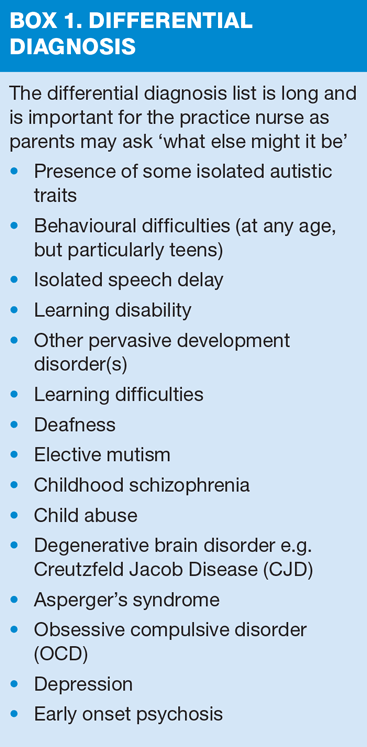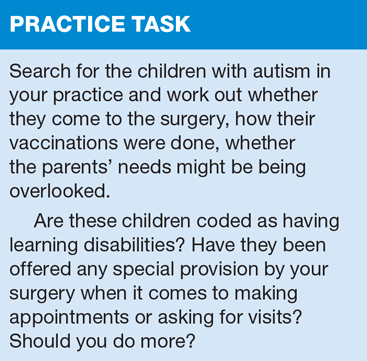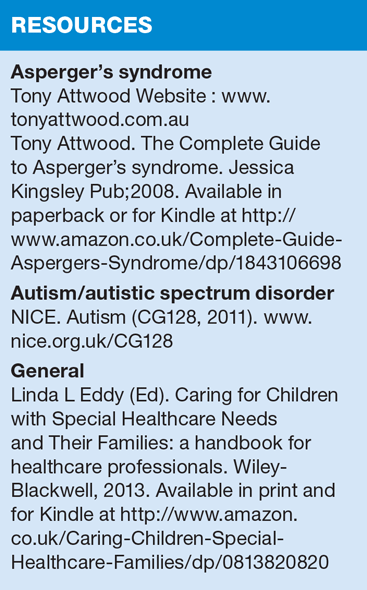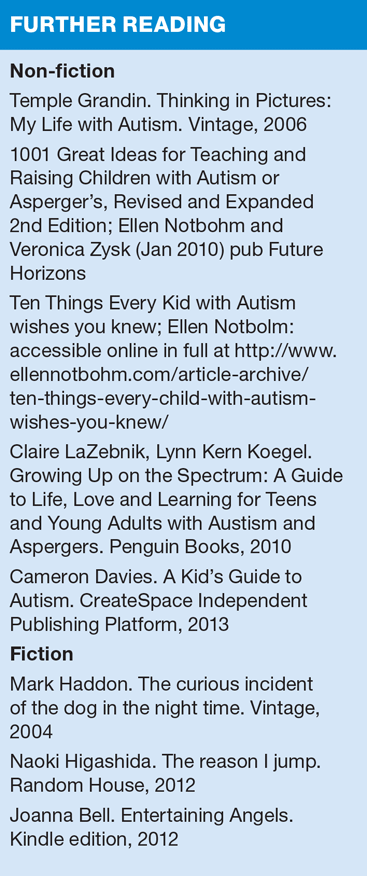Understanding autistic spectrum disorder
Dr Mary Lowth
Dr Mary Lowth
MA MB BChir FRCGP PGDertMedEd
GP and Examiner
Parents may commonly express concern over features of their child’s behaviour that are suggestive of autistic spectrum disorder. A working knowledge of the condition can help the practice nurse to provide appropriate advice
Autistic spectrum disorder (ASD) is a pervasive developmental disorder – one of a group of five related conditions that affect development, particularly:
- communication
- socialisation
- imagination.
Two of these conditions – autism/autistic spectrum disorder and Asperger’s syndrome are relatively common concerns raised by parents in the surgery. Parents may be worried that their child may have one of these conditions, or express concern about features suggestive of them. A working knowledge of what ASD is, the possible differential diagnoses and an understanding of where and how to refer can be very helpful to the practice nurse.
WHAT ARE THE AUTISTIC SPECTRUM DISORDERS?
There are five classified pervasive developmental disorders:
Autism/autistic spectrum disorder (ASD)
Asperger’s syndrome (AS)
Rett’s syndrome
Childhood Disintegrative Disorder (once called infantile dementia)
Pervasive Developmental Disorder – Not Otherwise Specified (PDD0-NOS).
Rett’s syndrome and CDD are not further discussed here as they are rare and catastrophic disorders involving loss of acquired developmental skills in toddlers. They are – thankfully – very rare.
The term PDD-NOS refers to children with socio-communicative problems but who are too able in that area to fit the diagnostic criteria for ASD or AS.
Pervasive developmental disorders affect function profoundly, and can impact on the child’s future in terms of relationships, education, future employment and even independent living. At the severe end of the spectrum they are associated with severe learning difficulties and the need for permanent residential care. Three quarters of children with autism have associated learning difficulties.
At the high-functioning end of the spectrum, appropriate support, adaptation and learning, and choice of environment and role can result in a normal life with some degree of personal ‘oddness’ as an adult. Even in these children the process of growing up may not always be easy, and will certainly be different for the affected child. The social impairments – especially in teenaged years – can cause great unhappiness and difficulties in forming lasting relationships, and the sometimes unusual or inappropriate manner is something that health professionals need to adapt to and be aware of.
CHARACTERISTICS
Autism/ASD
All people with autism have impairments in social interaction, social communication and imagination. This is referred to as the triad of impairments: and patients vary from intellectually able but apparently eccentric individuals to those with severe social and behavioural impairment.
The triad of difficulties
Socialisation: People with ASD have difficulty developing peer relationships and don’t seek to share enjoyment with other people. There is a lack of social or emotional reciprocity, and poor eye contact, often noticed early. Some people with autism ignore people, others approach them in inappropriate ways.
Communication: There is difficulty with verbal and non-verbal communication, for example not really understanding the meaning of gestures or facial expressions. Linguistic skills range from absence of speech to those who display complex, grammatically correct speech but with content that can be stilted or odd. High functioning individuals can learn to overcome many of the problems this causes by learning the things that come naturally to others – such as when to smile, or which questions are acceptable in a social setting. Spoken language development is often delayed, without attempts to compensate for its absence in other ways such as signing.
Imagination: Imaginative play is usually impaired. Focus on single play items of interest such as trains, dragons or dinosaurs is often a feature. There is a lack of understanding of emotions and reactions, and of alternative outcomes. It may appear that affected children are utterly rational to the point of being unable to see that there are ever alternative possibilities.
In addition to this triad people with autism resist changes in routine. They can seem unresponsive to discomforts such as cold or hunger, but abnormally sensitive to other stimuli such as sound or light. Repetitive motor mannerisms are common e.g. hand flapping, teeth grinding and screaming. They show insistence on rituals. Complex verbal activities may include fascination with certain topics, or learning the dialogue of films verbatim.
Sometimes, aggressive and/or self-injurious behavior may be present.
There is an association between autism and other neurological, psychological and behavioural conditions including epilepsy, ADHD, depression and psychosis.
Autistic savantism
Some people with autism have some special skill at a much higher level than the rest of their abilities – for example, music, art, numerical calculations or jigsaw puzzles
IQ and acquisition of useful speech by age 5 years are the best predictors of good outcome
Asperger’s syndrome
Asperger’s syndrome (AS) was described by Hans Asperger 1944.
A number of the traits of autism are seen in Asperger’s, but are less severe than in autism. These include:
Difficulty in communicating: people with AS usually have fewer problems with language although their speech content may sound formal or stilted and they may not take much notice of the reaction of people listening to them; they can be over-literal.
Difficulty in social relationships: unlike people with ‘classic’ autism, who often appear withdrawn, many people with AS want to be sociable. However, they may find it hard to understand non-verbal signals, including facial expressions, and there are usually marked difficulties with socialisation and befriending. Interests may be narrow, unusual, immature and unshared.
Difficulty with imagination: they often excel at learning facts and figures, but may find it hard to think in abstract ways. This can cause problems in school where they may be good at maths but find difficulty with other subjects, such as literature or religious studies.
People with AS are often of average or above average intelligence. They may have obsessive interests. They can display rigidity of thinking and inflexibility around routines.
PREVALENCE
Classical ‘Kanner’ autism has a prevalence of 0.2-0.5 per 1000. The figures for all ASD depend on how broadly it is defined – since this is a spectrum the cut-off points are not easy to specify – but almost certainly at least ten times as many.
Kanner autism is more prevalent in boys, but broader ASD is more equally divided between the sexes.
PRESENTATION
Autism/ASD presents in childhood, and it generally has a steady course without remission or relapse, although children can make sudden developmental leaps and leading to apparent improvement, particularly if they acquire language after a period of language delay.
Asperger’s syndrome may present later, sometimes even in the teens and rarely in adults.
A list of possible differential diagnoses is given in Box 1.
ASSESSMENT
Referral into the assessment system is usually through GPs or health visitors. Pre-assessment screening questionnaires are sent out n order that the clinics can select the right children to assess, as the assessment is a lengthy and expert process and resources are limited.
MANAGEMENT
Management is through a combination of educational, social and communicative approaches tailored to the individual child.
In the early years this may include music therapy (children often appear distressed by noise generally, and by musical specifically), pretend play therapy, speech therapy, sensory therapies, occupational therapy and behavioural therapy. Later this may include extra educational provision such as one-to-one teaching, smaller classes, quiet rooms, and anger management strategies.
Pre-school children are often seen in child development clinics – but later the emphasis is on an approach delivered through school or, where necessary, social care. Funding is often difficult and some children need to go out of their home area and into residential care in order to have their needs met.
Difficulties may arise because the behavioural age of the child in terms of social skills and ‘teachability’ may be different from their intellectual age. Many children with ASD are of normal or above normal IQ, and may function apparently normally in mainstream schools. However, it can be difficult for large busy schools to make sure that their social needs are met, and they often benefit if offered the smaller class sizes of independent schools. This is highly dependent on locality. Sadly, parents often have to fight prolonged battles for the right services for their child, and funding is always tight.
PROGNOSIS
Prognosis varies with the degree of the condition.
The minority, with Kanner autism, will not lead functionally normal independent lives, and need permanent residential care.
Others, at the opposite end of the spectrum, not only function ably in society but go on to lead successful professional lives, compensating for any impairment or difficulty in social function by their learned skills and by adapting to environments they find comfortable and that suit their strengths (as indeed we all do). Many such individuals would challenge any view that they are not ‘normal’. Certainly some of the described features of high functioning autism – such as awkwardness in social situations and a tendency to be blunt and factual without appreciating subtle emotional interactions may have been overcome by learning them – and in any case there is a clear overlap with ‘normal’.
PARENTING
Children with autism are a challenge to parent. Preschools may not accept them, ‘normal’ schools may not accommodate them easily and the right special schooling is not easy to find. There may be great difficulties to overcome. Even going out for a walk can be fraught with difficulty. Sitting in the practice waiting room can be a trial beyond endurance. Friends faced with a destructive or incomprehensible child may retreat, and parents can become prisoners in their own homes.
The practice nurse is well placed to consider the needs of the parent.
EFFECTS ON THE PRIMARY CARE CONSULTATION
In primary care it’s important to be aware that individuals with ASD, even if high functioning, may:
- find it difficult to organise themselves into accessing primary care
- not understand when they need to do so
- have difficulty communicating their problems
- interact socially in a way we find odd, presenting a challenge to our consultation skills
MMR VACCINATION
Autistic spectrum disorders have had a great deal of publicity in recent years, partly due to the now discredited claims of a link to MMR vaccination. There is no doubt that diagnoses have increased – but analysis suggests that this involves diagnosis of children on the spectrum as the condition has been more broadly defined, and that actual prevalence of Kanner autism has remained constant.
CHANGING CLASSIFICATIONS
Many people now refer to ‘the Spectrum’ as including both autism, autistic spectrum disorder and Asperger’s syndrome.
The overlap between Asperger’s syndrome and high-functioning autism (autism without intellectual impairment) is marked. The differing diagnoses mainly depends on the diagnostic history – with autism defined as children diagnosed before aged 20 months (with language impairment) and Asperger’s encompassing anyone diagnosed later than this whose language development was normal. However, the differences are otherwise difficult to characterise.
In May 2013 in the fifth edition of the Diagnostic and Statistical Manual of Mental Disorders (DSM-5) Asperger’s syndrome was included as a subset of ASD. However, the World Health Organization’s ICD-10 retains AS as a specifically defined condition, albeit one of the ASDs.
The spectrum is perhaps best thought of like the keys of a piano. Some keys represent autism. Others represent Asperger syndrome (showing considerable overlap in ability/disability with the more able people with autism). Other keys represent the other three conditions. They are on the same keyboard, but they are not the same.
THE PATIENT EXPERIENCE
Many high functioning ‘spectrum’ patients have written about their experience and perception of the world. Many other books now available, both for adults and children on the spectrum and for those who teach and care for them. A selection are mentioned below and it can be helpful to point parents to them.
For example, people on the spectrum often describe their sensory experiences as being unfiltered. They will state that being in a complicated environment is distressing and confusing as they are unable to filter out sounds and images which are not important and focus on those that are. This means that they are assailed by too much sensory information, some of which may be interpreted as dazzling or painful. They learn to cope with this by organizing their environment using rituals, patterns and repeated actions.
Cleary, the autistic spectrum overlaps with ‘normality’ – there is no absolute cut-off. Moreover people diagnosed with ASD may improve or adapt to the social and behavioural demands of their lives so that their diagnosis may become meaningless in adult life.
Related articles
View all Articles





